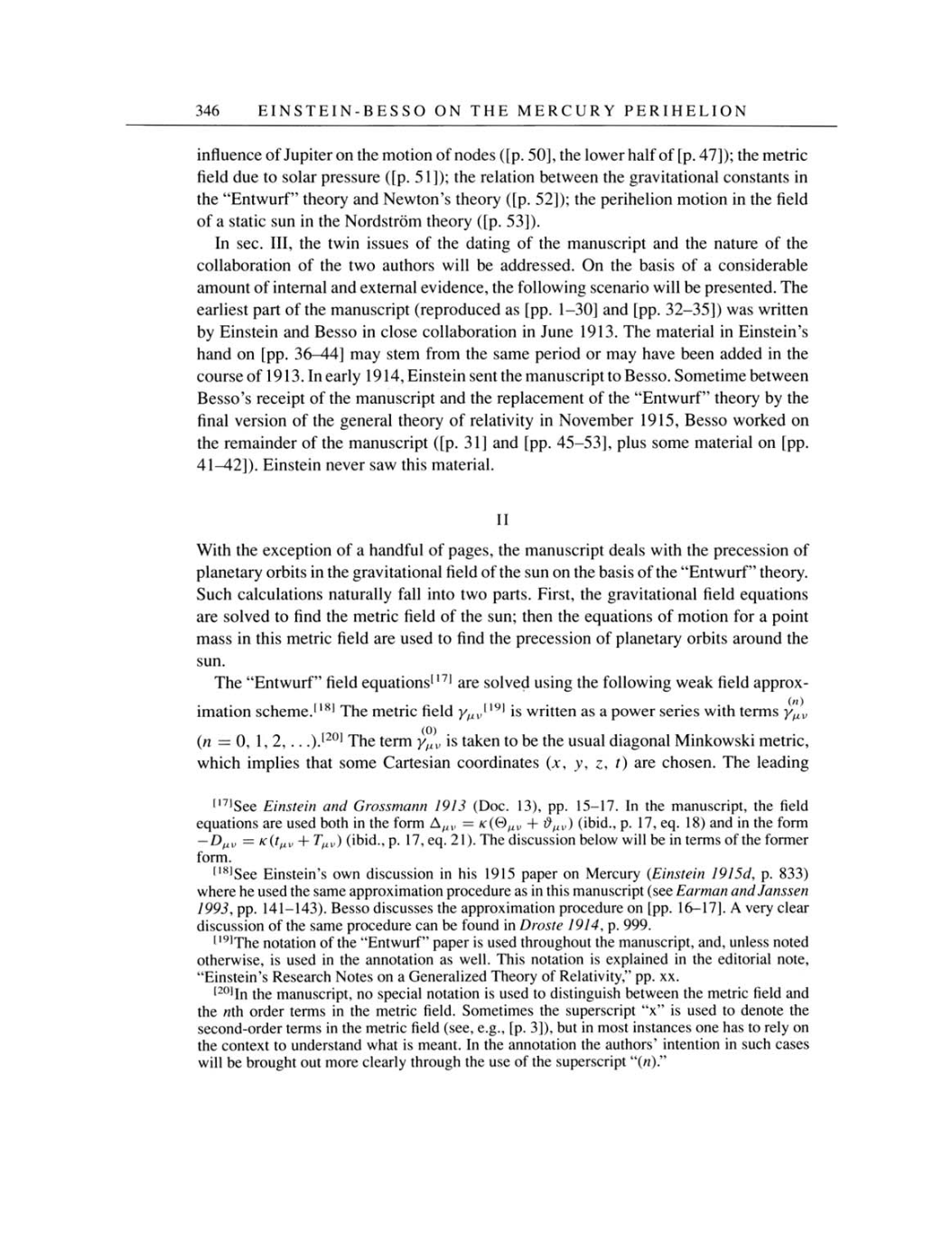346 EINSTEIN-BESSO ON THE MERCURY PERIHELION
influence of
Jupiter
on
the
motion of
nodes
([p.
50],
the
lower half
of
[p.
47]);
the
metric
field
due
to
solar
pressure
([p.
51]);
the
relation
between
the
gravitational
constants in
the
"Entwurf"
theory
and
Newton's
theory
([p.
52]);
the
perihelion
motion
in the field
of
a
static
sun
in the
Nordström
theory
([p.
53]).
In
sec. III,
the twin
issues of
the
dating
of
the
manuscript
and the nature
of
the
collaboration
of
the
two
authors
will be
addressed.
On the basis
of
a
considerable
amount
of
internal and
external
evidence, the
following
scenario
will be
presented.
The
earliest
part
of
the
manuscript (reproduced as
[pp.
1-30]
and
[pp.
32-35])
was
written
by
Einstein and Besso in
close collaboration
in
June
1913.
The
material
in
Einstein's
hand
on
[pp.
36-44] may
stem
from
the
same
period
or may
have been
added
in the
course
of
1913.
In
early
1914,
Einstein
sent the
manuscript to
Besso.
Sometime between
Besso's
receipt
of
the
manuscript
and the
replacement
of
the
"Entwurf"
theory
by
the
final
version of the
general theory
of
relativity in
November
1915,
Besso worked
on
the
remainder of
the manuscript
([p. 31]
and
[pp.
45-53],
plus some
material
on [pp.
41-42]).
Einstein
never saw
this
material.
II
With the
exception
of
a
handful of
pages,
the
manuscript
deals with the
precession
of
planetary
orbits
in the
gravitational
field
of
the
sun on
the
basis of
the
"Entwurf"
theory.
Such calculations
naturally
fall into two
parts.
First, the
gravitational
field
equations
are
solved
to find the
metric
field
of
the
sun;
then
the
equations
of motion for
a
point
mass
in this
metric
field
are
used
to
find the
precession
of
planetary
orbits around
the
sun
The "Entwurf"
field
equations[17] are
solved
using
the
following
weak
field
approx-
imation
scheme.[18]
The metric
field
y/lv[19]
is
written
as a
power
series
with
terms
y£v
(n
=
0,
1,
2,...).[20]
The
term
y°Jv
is
taken
to
be the usual
diagonal
Minkowski
metric,
which
implies
that
some
Cartesian coordinates
(x,
y, z,
t)
are
chosen.
The
leading
[17]See
Einstein and Grossmann
1913 (Doc.
13),
pp.
15-17.
In the
manuscript,
the field
equations
are
used
both
in
the
form
A,lv
=
k(0mu
+
(ibid.,
p.
17,
eq.
18)
and in the
form
-
=
K(t^v
+
Tflv)
(ibid.,
p.
17,
eq.
21).
The discussion
below will be in
terms
of
the
former
form.
[18]See Einstein's
own
discussion
in
his
1915
paper
on
Mercury (Einstein 1915d,
p. 833)
where
he
used
the
same
approximation procedure as
in this
manuscript (see
Earman and Janssen
1993,
pp.
141-143).
Besso discusses
the
approximation procedure
on [pp.
16-17]. A
very
clear
discussion of
the
same procedure
can
be
found
in
Droste
1914,
p.
999.
[19]The
notation of
the
"Entwurf"
paper is
used
throughout
the
manuscript,
and,
unless noted
otherwise, is
used
in
the
annotation
as
well.
This notation
is explained
in the
editorial
note,
"Einstein's Research Notes
on a
Generalized
Theory
of
Relativity," pp. xx.
[20]In
the
manuscript,
no
special
notation
is
used to
distinguish
between
the
metric
field and
the nth
order
terms in the
metric
field.
Sometimes
the
superscript
"x"
is
used to
denote
the
second-order terms in the
metric
field (see,
e.g.,
[p.
3]),
but in
most
instances
one
has to
rely on
the context
to
understand what
is meant.
In the
annotation
the
authors' intention in such
cases
will be
brought out more clearly through
the
use
of
the
superscript "(n)."
